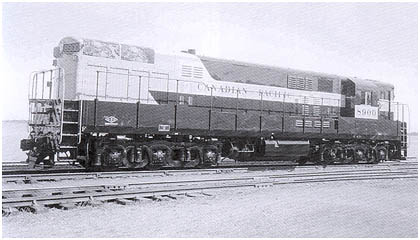|
Issue 1
June 2003

Canadian Pacific
Railway Employee Communications
Room 500 401-9th Ave S.W. Calgary AB
T2P 4Z4
MASTERS OF THE
WEST
Jonathan Hanna Corporate
Historian

Our Train Masters were mostly western
locomotives, ranging from Winnipeg to southern BC.
For a brief period
these powerful diesel-electric engines were the heavy-haul
workhorses of the CPR
The Canadian Locomotive Company (CLC), a trusted supplier of steam and diesel
locomotives to both CPR and CN, convinced each of the major Canadian railways, in
1955, to buy a Train Master. The Train Master model H24-66 was CPR's
highest horsepower diesel-electric locomotive yet.
Fairbanks-Morse built the prototypes in Beloit, Wisconsin, and CLC
finished the detail work in Kingston, Ontario.
The Train Master housed a Fairbanks-Morse 2,400-h.p.,
12-cylinder, opposed piston submarine engine, not unlike those that
powered half the US Second World War submarine fleet. Whereas in submarines the diesel
engine lay flat, in locomotives it was upright.
Until then CPR's most powerful locomotives were the three 2,250-h.p.
General Motors (Electro-Motive Division) E8A passenger
diesel-electrics used on the Montreal-Boston run. These
locomotives needed two engine blocks - for a total of 24 cylinders - to produce 150
less horsepower.
CPR liked what they saw in the Train Master and ordered 20 more, delivered in 1956.
CN didn't like it, and never ordered another. Four of the new order of Train Master
locomotives came with steam generators - two each. These locomotives, numbered 8901
to 8904, could be used in freight and passenger service. Although Train Masters were
quite a large locomotive - 20 metres (66 feet) long - they couldn't quite accommodate
two steam generators. So CLC added bulges over the walkways on the short end, so both
generators would fit. At first Train Masters operated long nose forward, but that put
the engineer some 15 metres (50 feet) from the front of the locomotive. CPR reversed
the controls on its Train Masters and most of the shorter H16-44s between
1959 and 1967 to run them short hood forward. CPR also removed the two steam
generators from each of the 8901 to 8904 Train Masters in 1960 and narrowed the short
hood exposing the walkways. In 1961 CPR removed the single steam generator from its
prototype Train Master - No. 8900.
Train Masters were mostly a western locomotive ranging from Winnipeg to southern B.C.
A small handful tested in Ontario, and some saw episodic use on transfer service in
Montreal and Toronto. The Cominco smelter at Trail and fertilizer plant at Warfield,
B.C., used Train Masters in heavy drag transfer service, including up a switchback
with a grade of more than four percent.
CPR didn't keep their Train masters in service very long. No. 8902 lasted only nine
years, 13 more Train Masters lasted barely a dozen years, another three lasted until
1972, No. 8903 was sold in 1974 and the final three - Nos. 8900, 8904, and 8905 - were
retired in 1976. No. 8900 had the distinction of being the first and last Train
Master on the system. CPR kept No. 8905 in its heritage collection and eventually
donated it to the Canadian Railroad Historical Association's Canadian Railway Museum
in St. Constant, Quebec. It is the only Train Master left in Canada and the United
States.
| |
Vital
Statistics
|
Numbers
|
8900-8920
|
Class
|
DRS-24
|
Builder
|
Fairbanks-Morse/CLC
(8900)
Canadian Locomotive Co. (8901-8920)
|
Outshopped
|
13 July 1955 (8900)
|
Builder's Model
|
H24-66
|
Horsepower
|
2,400
|
Cylinders
|
12
|
Axles
|
6
|
Maximum speed
|
75 mph (121 kph)
|
Length
|
66 ft. (20 m)
|
Width
|
10 ft. - 4.5 in. (3.2 m)
|
Height
|
15 ft. (4.6 m)
|
Weight
|
388,000 lbs. (176,000 kg) (8900)
|
Original Cost
|
$282,611 (8900)
|
©
2005 William C. Slim
http://www.okthepk.ca
|